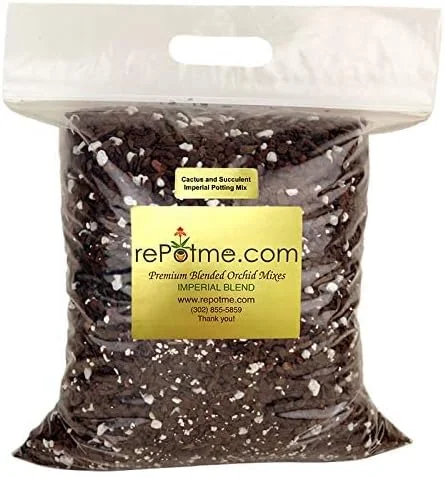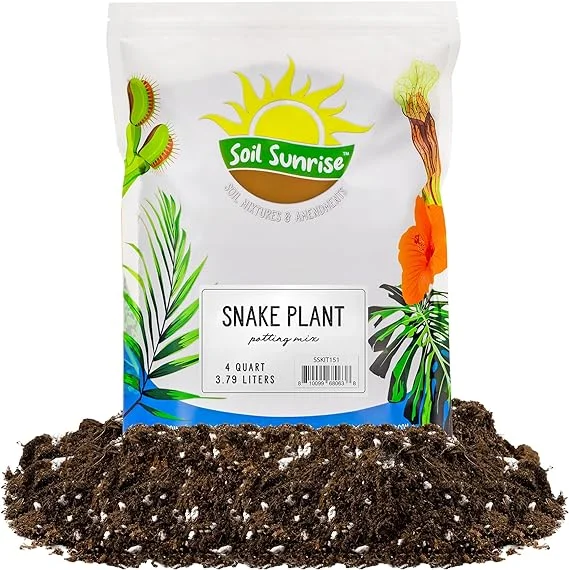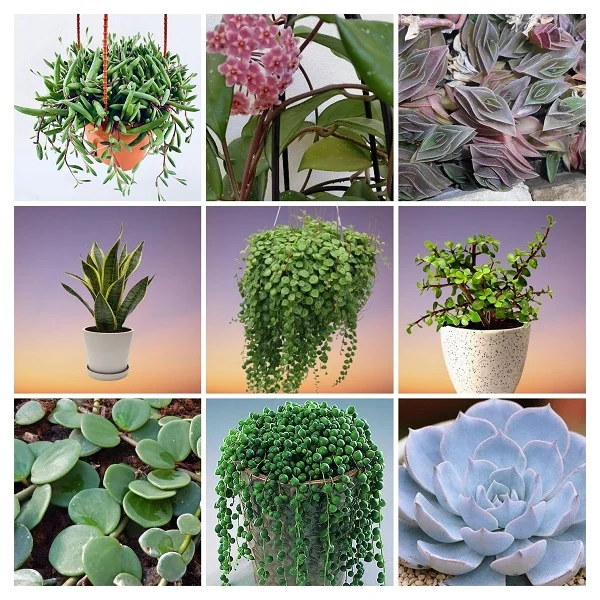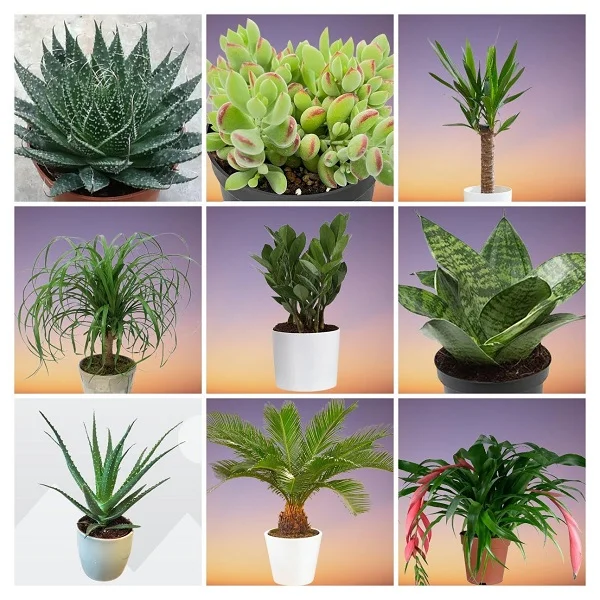Snake Plants (Sanseviera) Indoor Care and Growing Problems with Solutions
Some links in this post may be affiliate links
Snake Plants (Sanseviera) grows best in bright light with 6-8 hours of direct sunlight, average warmth and moderately moist, loose, rich, succulents soil coupled with monthly feeding in the growing season.
Mother-in-law's Tongue also called Devil's Tongue, Jinn's Tongue, Bow String Hemp or Snake Tongue are slow growing, low maintenance and extremely hardy plants which are also good air cleaners.
Bow String Hemp Plants are hard to kill plants which can withstand low light, dry air, drafts and periods without water. The major drawback for these plants is root-rot due to overwatering or soggy soil.
The leaves in Snake Plant species are typically arranged in a rosette around the growing point but in some species they are arranged in two-ranks.
Based on their leaves, Snake Plants can be categorised as hard-leaved or soft-leaved. Hard-leaved species have their origin in the arid climates while the soft-leaved species are native to the tropical and subtropical regions.
The hard-leaved species have several survival adaptations for the dry regions which include thick, succulent leaves for water storage and thick leaf cuticles to reduce loss of moisture.
The leaves in the hard-leaved species may also be cylindrical to reduce surface area, thus reduce water loss, and are usually shorter than those of the soft-leaved tropical species.
Snake Plants are evergreen, flowering plants which were formerly placed in the Sanseviera genus but have recently been reclassified into the Dracaena genus and now goes by the botanical name Dracaena trifasciata. Here are popular Dracaena varieties that you can successfully grow in the home.

Botanical name: Sanseviera
Synonym: Dracaena trifasciata
Family: Asparagaceae
Subfamily: Nolinoideae
Common names: Snake Plant, Mother-in-law's Tongue, Saint George's Sword Plant, Jinn's Tongue, Bow String Hemp, Snake Tongue
Origin
Sansevieria species which have recently been reclassified into the Dracaena Genus are native to Africa, Madagascar and southern Asia. In their natural envivornment, they grow as evergreen perennial plants forming dense stands and spreading by means of rhizomes. Snake Plants are some of the best tropical foliage plants that you can grow in home, office and any suitable place.
Air Purification
Snake Plants have been shown to be some of the best air-cleaning plants and get rid of formaldehyde, benzene, xylene, toulene and trichloroethylene from indoor air.
They also produce high levels of oxygen at night as they are CAM (Crassulacean Acidic Metabolism) plants. CAM plants are plants that harvest Carbon dioxide at night and use it during the day to make their food.
As the CAM plants make their food they store the oxygen they produce in the process and release it at night. This is an adaptation of CAM plants to their drought-prone climate which enables then survive the harsh climate.
Varieties
There are about 70 species of Snake Plants, many of them are favoured for their variegated foliage with yellow or silvery-white stripes on the leaf margins.
The low-growing rosette varieties like the Sansevieria Golden Hahnii and Sansevieria Hahnii are ideal for the small spaces like a windowsill or table-top. Check out these popular snake plants varieties that you can grow in any space.
Toxicity
Snake Plants are toxic to both humans and pets as indicated by ASPCA. They contain saponins which if ingested may cause nausea, vomiting and diarrhea. Keep these plants away from children and pets to avoid any mishaps.
Where to Buy
Are you looking to add the beautiful Snake Plants to your collection? You may acquire these plants online from Amazon (Link to Amazon).
How do you care for Snake Plants indoors?
To care for Snake Plants indoors, provide bright light with 6-8 hours of direct sunlight, warmth of 16-290C, humidity of 50-55% and moderately moist, loose, fertile, succulents soil coupled with monthly feeding during the growing season.
Snake Plants only require repotting when they become pot-bound. Pruning requires removal of dead leaves to keep the plant neat as well as reduce pest and disease infestations. Keep reading for more on these growing conditions and how to achieve them.

Watering
Water Snake Plants liberally in spring and summer while allowing the top 2-3 inches of soil to dry out between waterings. Keep the soil moderately moist and avoid overwatering to prevent yellowing and rotting.
Cut down on watering in fall and winter to maintain the soil barely moist. Do not allow the soil to dry out completely to prevent wilting and reduced growth.
Use water that is at room temperature to prevent cold shock which may lead to stunted growth. Ensure that the water is free of chlorine and other dissolved chemicals to avoid staining and brown leaf tips and edges.
Mother-in-law's Tongue Plants are prone to root-rot which is promoted by soggy soil, therefore, ascertain that the pot has a drainage hole and the soil is free-draining to prevent waterlogging.
Light Requirements
Snake Plants grow best in bright light with 6-8 hours of direct sunlight. They are very versatile plants which will adapt to both direct sunlight and lower light conditions.
However, in shade and low light conditions they will grow much slower while in deep shade they may die. Therefore, to accelerate growth you may use full spectrum grow lights if the the natural lighting is not enough.
Rotate the pot regularly to ensure that the plant receives adequate light on all sides for robust and uniform growth.
Temperature and Humidity
Snake Plants do well in a warmth of 16-290C as it mimicks their natural environment. A room temperature that is comfortable for you is ideal for this plant.
Though the plants are very tolerant to temperature changes, keep them away from sources of drafts as they can lead to reduced growth and eventual death of the plant.
Mother-in-law's Tongue Plants have no need for extra humidity; average humidity of 50-55% is ideal for these plants. Ensure that there is good air circulation to prevent fungal diseases.
Fertilizer
Feed Snake Plants monthly in spring and summer with a balanced, liquid fertilizer to encourage a lush growth. Stop feeding in fall and winter as growth is minimal at this time and feeding at this time can lead to fertilizer burn and death of the plant.
Potting Mix
The best soil for growing Snake Plants should be a loose, well-drained, sandy soil that is rich in organic matter to prevent it from getting soggy. Check out these 10 potting soil mixes perfect for Snake Plants grown indoors.
Repotting
Repot Mother-in-law's Tongue Plant at the beginning of the growing season (spring to early summer), only when it becomes crowded in its current pot. You can divide a large plant during repotting to propagate new plants.
Use a pot 1 size larger than the current one. Ensure that the pot has a drainage hole and the soil is well-draining to prevent root-rot. Take a look at these succulents pots available on Amazon.
Pruning & Grooming
Pruning Snake Plants involves removal of any dead or diseased leaves to minimize pest and disease infestations. Cut the leaves with a clean, sharp pair of pruning scissors at the soil level to maintain the plant neat and tidy.
Occasionally clean the leaves by damp-wiping with a soft cloth to get rid of dust and discourage pest and disease infestations.
Propagation
Snake Plants (Sanseviera) propagation is done at the beginning of the growing season by plant division or from leaf cuttings which can be rooted either in water or in soil.
Learn how to propagate Snake Plants by 4 propagation methods.
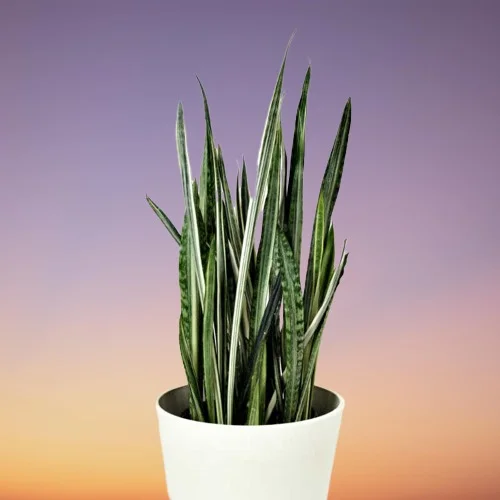
Snake Plant (Sanseviera) Problems with Fixes
Snake Plant (Sanseviera) growing problems are leaf spots, brown leaf tips, bloated and stinky leaves, blotches, rotting, pests and diseases among others. Keep reading for more on these problems, their solutions and remedies.
Pests
Common pests on Snake Plants are mealy bugs and spider mites. Isolated the affected plant to prevent spread to other plants and treat it with neem oil or insecticidal soap as directed by the manufacturers.
Rotting base, yellow leaves and die back
The cause of rotting base, yellow leaves and die back in Snake Plant is root-rot which is promoted by soggy soil due to poor soil drainage.
Slip the plant from its pot and inspect the roots. Cut off the affected moldy, mushy roots. Treat the healthy roots with a fungicidal solution and repot the plant in fresh soil and fresh pot.
Thoroughly clean the pot with the fungicidal solution or discard it to avoid future contamination. Place the repotted plant in a warmer place and maintain the soil on the dry side. If the entire plant is affected discard it as it cannot be saved.
Brown and crunchy leaf spots
Brown and crunchy leaves in Snake Plant are caused by underwatering. If there isn't enough moisture in the soil, the leaves develop brown and crunchy spots. Remove the affected leaves by cutting with a sharp, sterilized knife.
Water the plant immediately. Thereafter, water when the top 2-3 inches of soil dry out to keep the soil slightly moist but never allow the soil to dry out completely.
Bloated and stinky leaves
Bloated and stinky leaves in Snake Plant are due to overwatering or soggy soil. The excess water in the soil causes the plant cells to explode within the leaves leading to bloating and odor.
Remove the affected leaves by cutting with a sharp, sterilized knife or a pair of scissors.
Check the drainage of both the soil and the pot. Ensure that the pot has a drainage hole and the soil is free-draining to prevent the soil from getting soggy.
Reduce watering and allow the soil to dry out between waterings. Never allow the plant to sit in soggy soil.
Brown leaf tips
The are two possible causes of brown leaf tips on Snake Plant. Don't remove the brown tips as it leads to scarring.
One possible cause of brown leaf tips on Snake Plant is inconsistent watering. Do not water on a schedule; water when the top 2-3 inches of soil feel dry to the touch.
The second possible cause of brown leaf tips on Snake Plant is overwatering. The remedy is to adjust the watering schedule and to let the plant recover on its own. Water the plant moderately while allowing the top 2-3 inches of soil to dry out between waterings and never allow the soil to dry out completely.
Leaf scarring
The cause of leaf scarring in Snake Plant is too much touching of the leaves or brushing against them. Avoid touching the leaves unnecessarily and place it away from the line of traffic.
Brown blotches on the leaves
Brown blotches on the leaves of Snake Plant are due to a non-infectious disorder which starts at the tips working downwards along the leaf. The cause is not know and there is no known cure.
Frequently Asked Questions
1. How do I increase my Snake Plant growth?
To increase the growth of your Snake Plant, ensure its is getting very bright light with at least 6-8 hours of direct sunlight, warmth of 16-290C and moderately moist, loose, fertile, succulents soil coupled with monthly feeding during the growing season.
2. Can Snake Plant grow without sunlight?
Although a Snake Plant can grow without sunlight, it will grow much slower and it will not reach its optimum growth.
3. Why is my Snake Plant dying?
The 2 most common reasons why your Snake Plant is dying is soggy soil and inadequate light. Snake Plants cannot tolerate soggy soil and it oftens leads to root-rot and eventual death of the plant.
When a Snake Plant does not receive very bright light with some direct sunlight, the growth slows down. If the situation continues for a long period of time, the plant deteriorates and begins to die.
4. How often should I water a Snake Plant?
During the growing season, water your Snake Plant liberally until water drips through the drainage hole while allowing the top 2-3 inches of soil to dry out between waterings.
Significantly cut down on watering in the cold period to keep the soil slightly moist but do not let it to dry out completely.
5. How do I know if my Snake Plant is getting enough water?
Wilting is a sign that your Snake Plant is not getting enough water. The leaves of a well watered Snake Plant are firm and stiff. Make sure to maintain the soil moderately moist during the growing season and slightly moist in the cold season but never allow the soil to dry out completely.
6. How do I keep my Snake Plant happy?
To keep your Snake Plant happy provide it with the proper growing conditions; very bright light with 6-8 hours of direct sunshine, average warmth of 16-290C and moderately moist, loose, fertile, succulents potting mix and monthly feeding during the growing season.
7. How do I force my Snake Plant to bloom?
To force your Snake Plant to bloom, grow it in a slightly small pot so that its overcrowded in the pot. Once pot-bound and mature it will begin to bloom. In addition, ensure to give it optimum growing conditions and a phosphorous-rich fertilizer to boost blooming.
8. How do I get my Snake Plant to have babies?
To get your Snake Plant to produce babies, give it the right growing conditions i.e. very bright light with 6-8 hours of direct sunlight, average warmth (16-290C) and moderately moist, loose, fertile, succulents potting medium accompanied with monthly feeding during the growing season.
9. How do you treat an overwatered Snake Plant?
To save an overwatered Snake Plant, remove the plant from its pot and inspect the roots. Cut off the affected moldy, mushy roots. Cut away any damaged leaves at the base. Treat the healthy roots with a fungicidal solution and repot the plant in fresh soil and a fresh pot. Place the repotted plant in a well-lit, warm place and maintain the soil on the dry side for about 7 days before resuming watering.
10. What is the best fertilizer for Snake Plant?
The best fertilizer for Snake Plant is a balanced, water-soluble fertilizer to boost foliage growth. It should be applied every 4 weeks during the growing season for best results. To promote blooming go for a phosphorous-rich fertilizer.
You liked it? Share on social media.
Related Content
Amazon Associates Disclosure
Homeplantsguide.com is a participant in the Amazon Services LLC Associates Program, an affiliate advertising program designed to provide a means for sites to earn advertising fees by advertising and linking to amazon.com.
